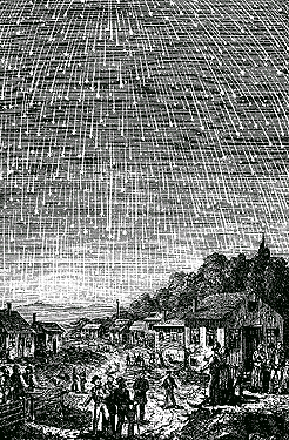It's time for the Leonids meteor shower. This meteor shower, occurring every year in mid-November, is due to a cloud of debris left in the Earth's orbit by the periodic comet Tempel-Tuttle (55P/Tempel-Tuttle). This comet was discovered in 1865 and last appeared in our solar system in 1998. It has a period of 33 years so won't reappear until 2031. With each pass through our inner solar system, however, it leaves a trail of primarily dust-sized particles that we intersect. These particle burn up in our atmosphere in spectacular streaks of light we call "shooting stars" or meteors.
The best time to observe the Leonids is after midnight in the early morning hours of Wednesday, November 17 or Thursday, November 18. Why are meteor showers best after midnight?
The Leonids are so-named because they appear to emanate from the constellation of Leo the lion. Leo rises after midnight in the eastern sky and is actually quite easy to recognize - it looks like a backwards question mark and triangle.
Two problems with viewing the Leonids. This first is that a waxing gibbous moon will be out (it's full on the 21st). It doesn't set until around 2 am Wednesday morning and 3 am Thursday morning. The moon will wash out many of the fainter meteors when it's out. The second problem is significant and sadly typical for Ulster County. It will likely be raining early Wednesday morning and mostly cloudy early Thursday morning. The weather in this area absolutely sucks for doing astronomy.
This year, the Leonids might appear at a rate of 20 meteors or so per hour but there have been times when it's been dramatically higher - these are called meteor storms. On November 12 in 1883, the Leonids produced over 25,000 meteors per hour! People gathered on the streets and were convinced the world was coming to an end.
On November 17, 1996, another Leonids storm produced an estimated 144,000 meteors an hour - that's 40 per second! Here are some eyewitness accounts of the 1966 Leonids meteor storm.
The best Leonids shower I observed was in 2001 when the rate was one every few seconds (and some leaving spectacularly long trails).
If you'd like to read more about the history of the Leonids, there's a nice article at Space.com.
So if you find youself up around 4 am during the next two days, poke your head out and look up - you might be treated to a celestial show.







No comments:
Post a Comment